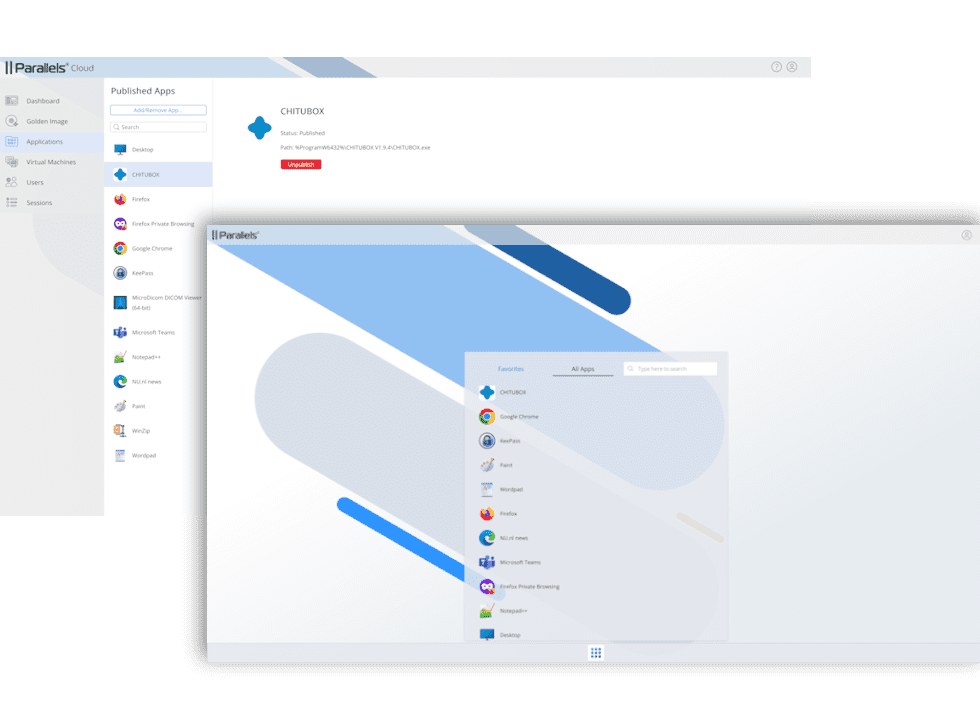
Unpacking Desktop as a Service (DaaS): A powerful tool for modern workforces
DaaS is a cloud-based model where a third-party provider hosts and delivers virtual desktops to users. Unlike traditional VDI, which requires organizations to manage their own on-premises infrastructure, DaaS offers a more straightforward, pay-as-you-go solution.
Leading providers like Parallels offer convenient access to virtual desktops, eliminating the need for upfront investments in hardware and software.
How does DaaS work?
DaaS leverages private or public cloud services, enabling multiple users to access virtual desktops over the Internet. The cloud provider takes care of everything, from infrastructure management to security, ensuring seamless and reliable access to virtual desktops. With an internet connection, users can access their desktops from any device, anywhere, using an endpoint application or web browser.
The benefits of DaaS
DaaS offers numerous benefits for organizations, including:
- Increased productivity: Employees can work from anywhere, anytime, if they have an internet connection and a suitable device.
- Lower costs: DaaS eliminates the need for upfront hardware and infrastructure investments, offering a more predictable cost structure.
- Enhanced security: Cloud providers manage security and compliance, ensuring excellent protection against cyber threats.
- Improved scalability: DaaS allows organizations to quickly scale their desktop infrastructure up or down as needed, adapting to changing business requirements.
- Reduced IT burden: DaaS frees IT staff from managing desktop infrastructure, allowing them to focus on strategic initiatives.
DaaS vs VDI
While DaaS offers several advantages, it is essential to compare it with traditional VDI to understand its suitability for your organization:
- Cost: DaaS has a lower upfront cost with a pay-as-you-go model, while VDI requires CapEx upfront to set up the IT infrastructure.
- Management needs: With DaaS, third-party management takes care of everything. With VDI, the organization is responsible for storage, computing, and network requirements.
- Capabilities: DaaS has some limitations compared to VDI, which offers advanced capabilities like USB redirection and multiple monitors.
- Regulatory requirements: DaaS may not align with certain industry regulations or compliance requirements, whereas VDI may meet more industry-specific security needs.
- Control: DaaS requires less in-house IT management due to third-party management of the solution, while VDI requires more time and effort since IT has greater control over the virtualized desktops and infrastructure.
- Usability: DaaS suits smaller organizations with proportionally lower needs, while VDI is suitable for larger organizations with higher security needs.
In summary, the choice between DaaS and VDI depends on your organization’s specific needs and resources. DaaS is ideal for organizations that:
- Need a flexible and scalable desktop solution.
- Have limited IT resources.
- Want to reduce costs.
- Prioritize security.
VDI, on the other hand, is better suited for organizations that:
- Require a high level of control over their desktop environments.
- Have the resources to manage their own infrastructure.
- Need to comply with industry-specific regulations and compliance standards.
Which companies benefit most from DaaS?
Many companies are increasingly transitioning to the DaaS model due to its benefits. Some of the organizations that can benefit from a shift to DaaS offerings include:
- Small and medium-sized businesses (SMBs) that want to reduce IT costs and improve flexibility. Such businesses can use DaaS to minimize the need for buying servers, software and other services.
- Enterprises that need to quickly deploy virtual applications and desktops to support new business initiatives or otherwise scale up or down readily. Depending on the business demands, these companies can leverage DaaS to provision or de-provision virtual desktops for their employees quickly.
- Organizations that want to centralize IT management capabilities and minimize IT costs. Utilizing DaaS allows IT administrators to easily deploy, configure, and maintain corporate resources from a single pane of glass.
How do you pick the right DaaS provider?
Before choosing an appropriate DaaS provider, you must first determine if DaaS or Desktop as a Service is the right approach for your organizational needs.
For example, you could have a scenario where employees are used to accessing resources through local PCs in an on-premises IT infrastructure. In this type of environment, it makes business sense to determine if a transition to cloud-based VDI can save costs and free up more resources.
Start by weighing the merits and demerits of VDI versus DaaS. For instance, do you have the necessary virtualization expertise, time, and other tools to manage on-premises IT infrastructure in-house, or would transitioning to DaaS make more business sense?
The future of work with DaaS
DaaS represents a significant advancement in desktop solutions, enabling organizations to embrace a more agile and efficient work environment. Its inherent benefits, like increased productivity, cost savings, and enhanced security, make DaaS a compelling choice for businesses of all sizes.
As DaaS offerings continue to evolve, these solutions are poised to become an essential tool for the modern workforce. As businesses seek to embrace modern work practices, understanding the benefits and challenges of DaaS is crucial.
By making informed decisions about their desktop infrastructure, organizations can unlock new levels of efficiency, cost-effectiveness, and security to thrive in the competitive landscape.
Discover Parallels DaaS

Parallels DaaS stands as a testament to the power of desktop as a service, offering organizations a comprehensive and secure solution tailored to their unique needs.
Our platform empowers businesses to enhance employee productivity, optimize costs, and achieve greater flexibility in a rapidly changing world.
Check out Parallels DaaS today.


